Business Strategy of Vodafone: Macro Environment and Internal Analysis
VerifiedAdded on 2020/07/23
|12
|4374
|53
Report
AI Summary
This report provides a comprehensive analysis of Vodafone's business strategy, examining the impact of the macro environment, including political, economic, social, technological, legal, and environmental factors (PESTLE analysis). It assesses Vodafone's internal environment using VRIO analysis to identify strengths and weaknesses, strategic capabilities, and competitive advantages. The report further explores the competitiveness of the telecommunications sector, particularly in the UK, and evaluates strategic directions and growth options available to Vodafone, such as market penetration, market development, product development, and diversification using Ansoff's growth vector matrix. The analysis considers Vodafone's global operations, brand strength, and financial performance, offering insights into its market position and future strategic choices. The report concludes with a summary of key findings and recommendations for Vodafone's continued success in the competitive telecommunications landscape.
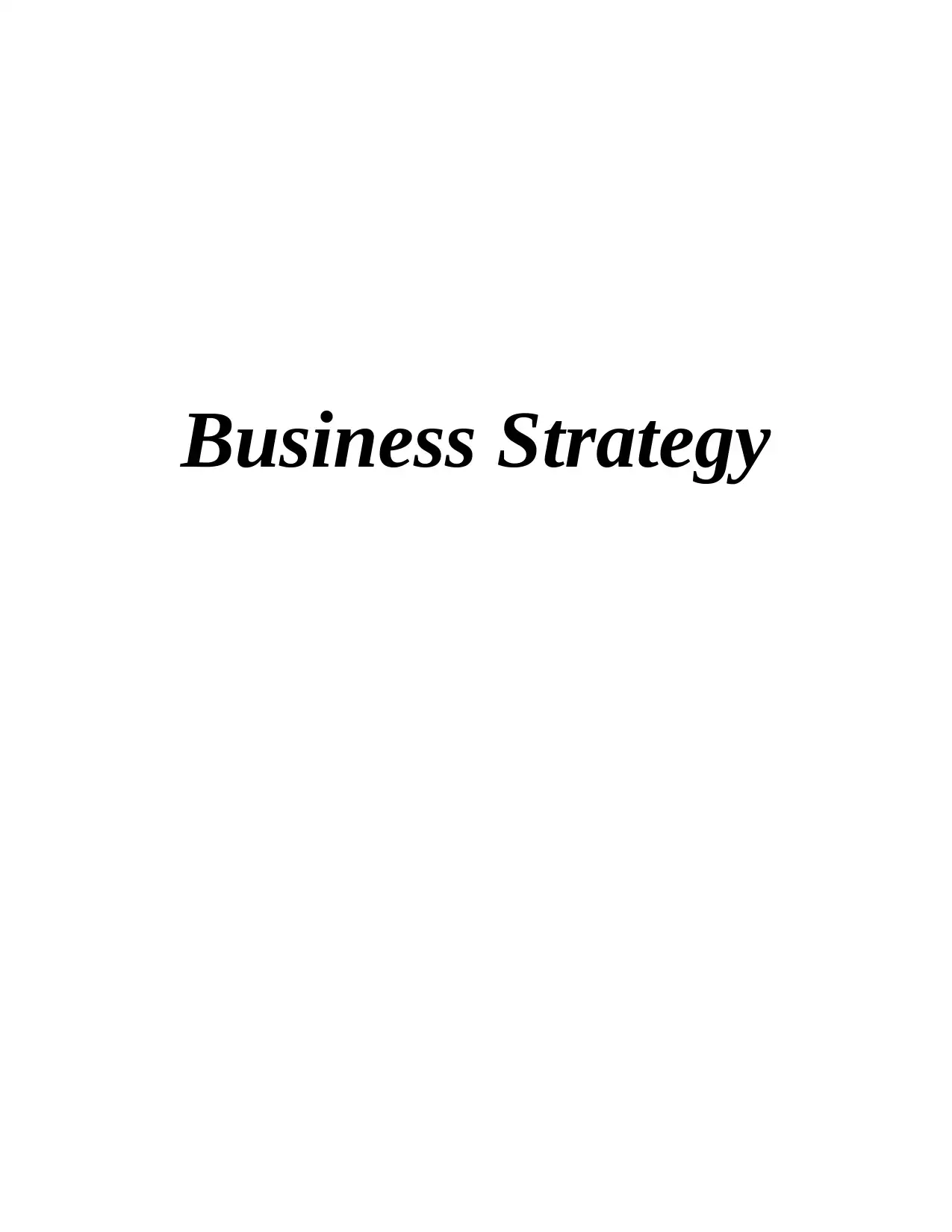
Business Strategy
Paraphrase This Document
Need a fresh take? Get an instant paraphrase of this document with our AI Paraphraser
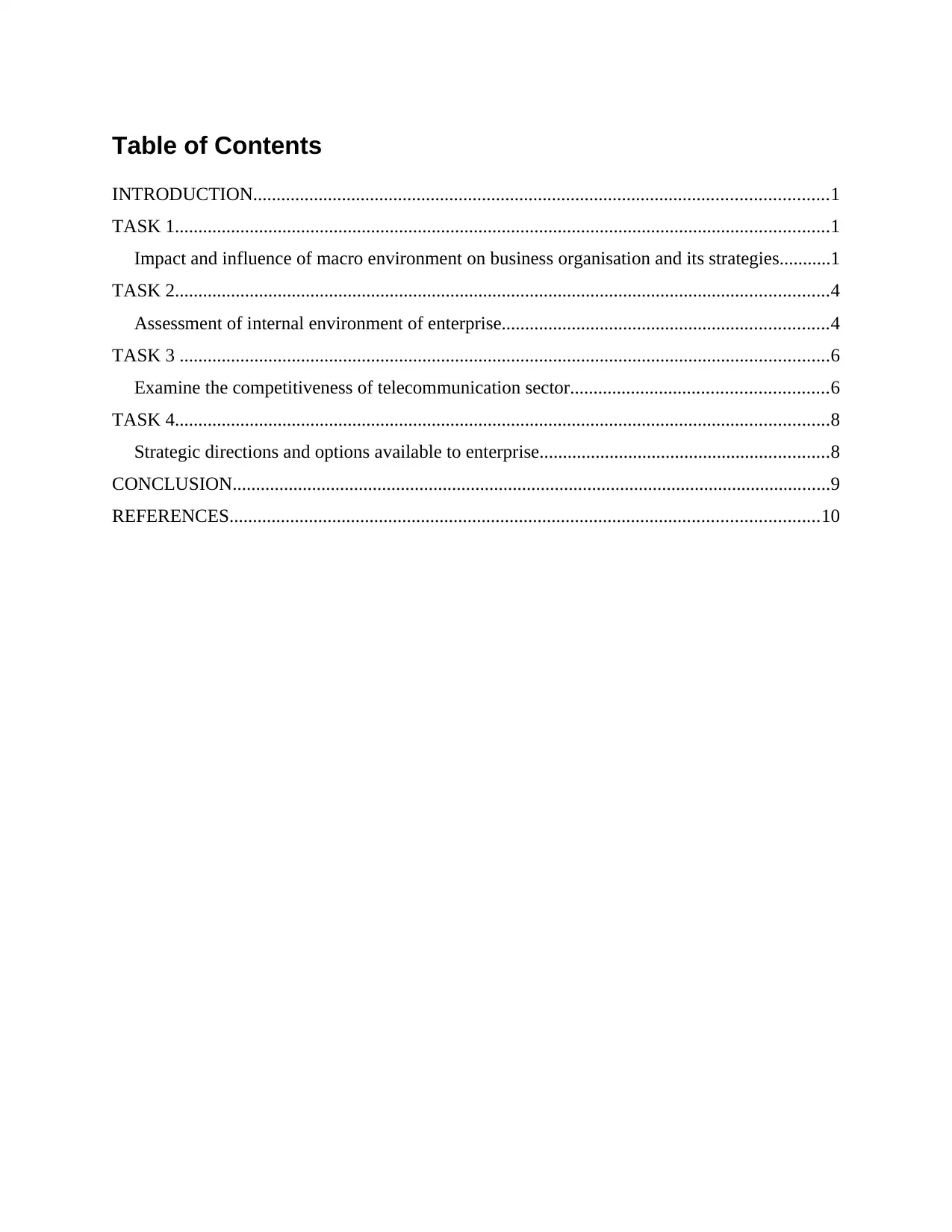
Table of Contents
INTRODUCTION...........................................................................................................................1
TASK 1............................................................................................................................................1
Impact and influence of macro environment on business organisation and its strategies...........1
TASK 2............................................................................................................................................4
Assessment of internal environment of enterprise......................................................................4
TASK 3 ...........................................................................................................................................6
Examine the competitiveness of telecommunication sector.......................................................6
TASK 4............................................................................................................................................8
Strategic directions and options available to enterprise..............................................................8
CONCLUSION................................................................................................................................9
REFERENCES..............................................................................................................................10
INTRODUCTION...........................................................................................................................1
TASK 1............................................................................................................................................1
Impact and influence of macro environment on business organisation and its strategies...........1
TASK 2............................................................................................................................................4
Assessment of internal environment of enterprise......................................................................4
TASK 3 ...........................................................................................................................................6
Examine the competitiveness of telecommunication sector.......................................................6
TASK 4............................................................................................................................................8
Strategic directions and options available to enterprise..............................................................8
CONCLUSION................................................................................................................................9
REFERENCES..............................................................................................................................10
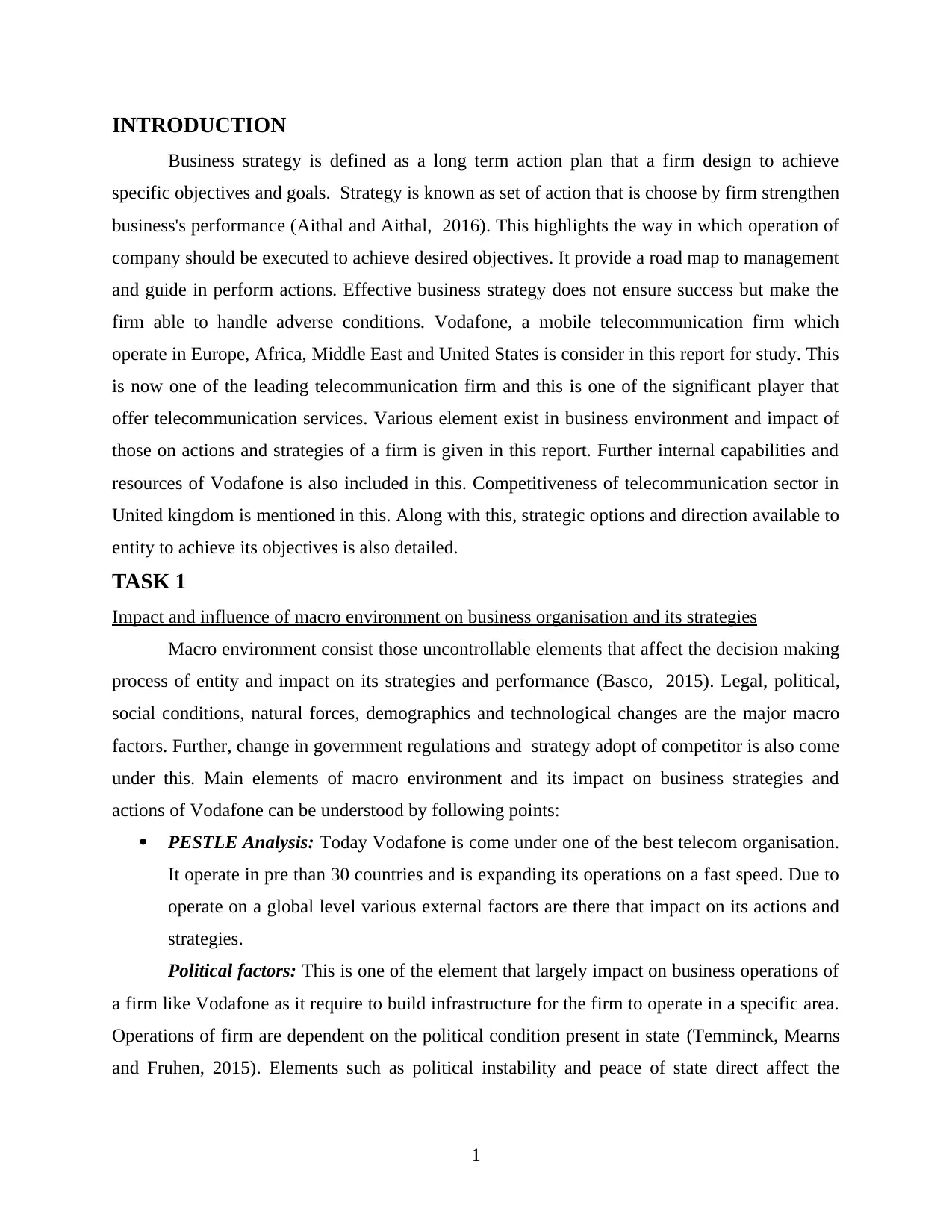
INTRODUCTION
Business strategy is defined as a long term action plan that a firm design to achieve
specific objectives and goals. Strategy is known as set of action that is choose by firm strengthen
business's performance (Aithal and Aithal, 2016). This highlights the way in which operation of
company should be executed to achieve desired objectives. It provide a road map to management
and guide in perform actions. Effective business strategy does not ensure success but make the
firm able to handle adverse conditions. Vodafone, a mobile telecommunication firm which
operate in Europe, Africa, Middle East and United States is consider in this report for study. This
is now one of the leading telecommunication firm and this is one of the significant player that
offer telecommunication services. Various element exist in business environment and impact of
those on actions and strategies of a firm is given in this report. Further internal capabilities and
resources of Vodafone is also included in this. Competitiveness of telecommunication sector in
United kingdom is mentioned in this. Along with this, strategic options and direction available to
entity to achieve its objectives is also detailed.
TASK 1
Impact and influence of macro environment on business organisation and its strategies
Macro environment consist those uncontrollable elements that affect the decision making
process of entity and impact on its strategies and performance (Basco, 2015). Legal, political,
social conditions, natural forces, demographics and technological changes are the major macro
factors. Further, change in government regulations and strategy adopt of competitor is also come
under this. Main elements of macro environment and its impact on business strategies and
actions of Vodafone can be understood by following points:
PESTLE Analysis: Today Vodafone is come under one of the best telecom organisation.
It operate in pre than 30 countries and is expanding its operations on a fast speed. Due to
operate on a global level various external factors are there that impact on its actions and
strategies.
Political factors: This is one of the element that largely impact on business operations of
a firm like Vodafone as it require to build infrastructure for the firm to operate in a specific area.
Operations of firm are dependent on the political condition present in state (Temminck, Mearns
and Fruhen, 2015). Elements such as political instability and peace of state direct affect the
1
Business strategy is defined as a long term action plan that a firm design to achieve
specific objectives and goals. Strategy is known as set of action that is choose by firm strengthen
business's performance (Aithal and Aithal, 2016). This highlights the way in which operation of
company should be executed to achieve desired objectives. It provide a road map to management
and guide in perform actions. Effective business strategy does not ensure success but make the
firm able to handle adverse conditions. Vodafone, a mobile telecommunication firm which
operate in Europe, Africa, Middle East and United States is consider in this report for study. This
is now one of the leading telecommunication firm and this is one of the significant player that
offer telecommunication services. Various element exist in business environment and impact of
those on actions and strategies of a firm is given in this report. Further internal capabilities and
resources of Vodafone is also included in this. Competitiveness of telecommunication sector in
United kingdom is mentioned in this. Along with this, strategic options and direction available to
entity to achieve its objectives is also detailed.
TASK 1
Impact and influence of macro environment on business organisation and its strategies
Macro environment consist those uncontrollable elements that affect the decision making
process of entity and impact on its strategies and performance (Basco, 2015). Legal, political,
social conditions, natural forces, demographics and technological changes are the major macro
factors. Further, change in government regulations and strategy adopt of competitor is also come
under this. Main elements of macro environment and its impact on business strategies and
actions of Vodafone can be understood by following points:
PESTLE Analysis: Today Vodafone is come under one of the best telecom organisation.
It operate in pre than 30 countries and is expanding its operations on a fast speed. Due to
operate on a global level various external factors are there that impact on its actions and
strategies.
Political factors: This is one of the element that largely impact on business operations of
a firm like Vodafone as it require to build infrastructure for the firm to operate in a specific area.
Operations of firm are dependent on the political condition present in state (Temminck, Mearns
and Fruhen, 2015). Elements such as political instability and peace of state direct affect the
1
⊘ This is a preview!⊘
Do you want full access?
Subscribe today to unlock all pages.

Trusted by 1+ million students worldwide
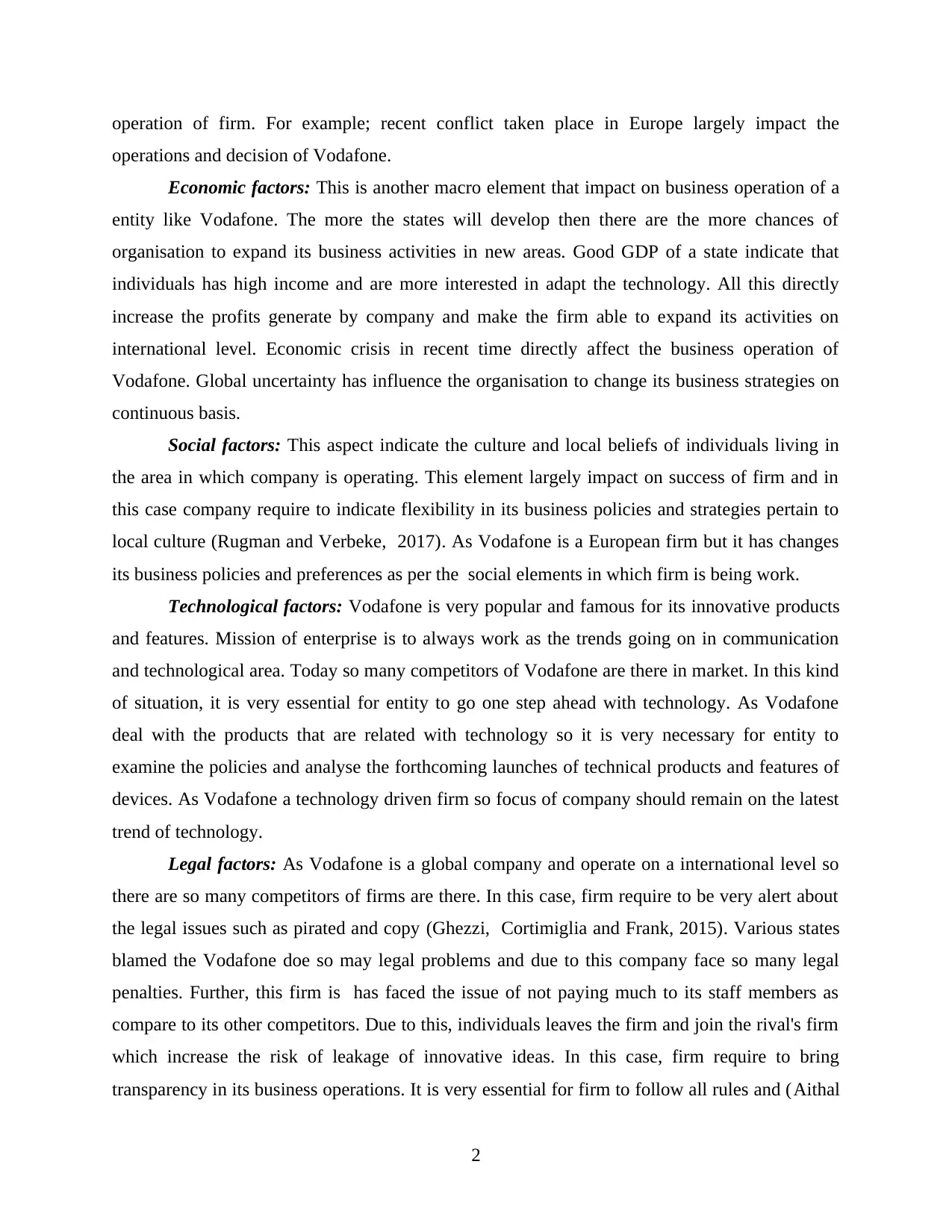
operation of firm. For example; recent conflict taken place in Europe largely impact the
operations and decision of Vodafone.
Economic factors: This is another macro element that impact on business operation of a
entity like Vodafone. The more the states will develop then there are the more chances of
organisation to expand its business activities in new areas. Good GDP of a state indicate that
individuals has high income and are more interested in adapt the technology. All this directly
increase the profits generate by company and make the firm able to expand its activities on
international level. Economic crisis in recent time directly affect the business operation of
Vodafone. Global uncertainty has influence the organisation to change its business strategies on
continuous basis.
Social factors: This aspect indicate the culture and local beliefs of individuals living in
the area in which company is operating. This element largely impact on success of firm and in
this case company require to indicate flexibility in its business policies and strategies pertain to
local culture (Rugman and Verbeke, 2017). As Vodafone is a European firm but it has changes
its business policies and preferences as per the social elements in which firm is being work.
Technological factors: Vodafone is very popular and famous for its innovative products
and features. Mission of enterprise is to always work as the trends going on in communication
and technological area. Today so many competitors of Vodafone are there in market. In this kind
of situation, it is very essential for entity to go one step ahead with technology. As Vodafone
deal with the products that are related with technology so it is very necessary for entity to
examine the policies and analyse the forthcoming launches of technical products and features of
devices. As Vodafone a technology driven firm so focus of company should remain on the latest
trend of technology.
Legal factors: As Vodafone is a global company and operate on a international level so
there are so many competitors of firms are there. In this case, firm require to be very alert about
the legal issues such as pirated and copy (Ghezzi, Cortimiglia and Frank, 2015). Various states
blamed the Vodafone doe so may legal problems and due to this company face so many legal
penalties. Further, this firm is has faced the issue of not paying much to its staff members as
compare to its other competitors. Due to this, individuals leaves the firm and join the rival's firm
which increase the risk of leakage of innovative ideas. In this case, firm require to bring
transparency in its business operations. It is very essential for firm to follow all rules and (Aithal
2
operations and decision of Vodafone.
Economic factors: This is another macro element that impact on business operation of a
entity like Vodafone. The more the states will develop then there are the more chances of
organisation to expand its business activities in new areas. Good GDP of a state indicate that
individuals has high income and are more interested in adapt the technology. All this directly
increase the profits generate by company and make the firm able to expand its activities on
international level. Economic crisis in recent time directly affect the business operation of
Vodafone. Global uncertainty has influence the organisation to change its business strategies on
continuous basis.
Social factors: This aspect indicate the culture and local beliefs of individuals living in
the area in which company is operating. This element largely impact on success of firm and in
this case company require to indicate flexibility in its business policies and strategies pertain to
local culture (Rugman and Verbeke, 2017). As Vodafone is a European firm but it has changes
its business policies and preferences as per the social elements in which firm is being work.
Technological factors: Vodafone is very popular and famous for its innovative products
and features. Mission of enterprise is to always work as the trends going on in communication
and technological area. Today so many competitors of Vodafone are there in market. In this kind
of situation, it is very essential for entity to go one step ahead with technology. As Vodafone
deal with the products that are related with technology so it is very necessary for entity to
examine the policies and analyse the forthcoming launches of technical products and features of
devices. As Vodafone a technology driven firm so focus of company should remain on the latest
trend of technology.
Legal factors: As Vodafone is a global company and operate on a international level so
there are so many competitors of firms are there. In this case, firm require to be very alert about
the legal issues such as pirated and copy (Ghezzi, Cortimiglia and Frank, 2015). Various states
blamed the Vodafone doe so may legal problems and due to this company face so many legal
penalties. Further, this firm is has faced the issue of not paying much to its staff members as
compare to its other competitors. Due to this, individuals leaves the firm and join the rival's firm
which increase the risk of leakage of innovative ideas. In this case, firm require to bring
transparency in its business operations. It is very essential for firm to follow all rules and (Aithal
2
Paraphrase This Document
Need a fresh take? Get an instant paraphrase of this document with our AI Paraphraser
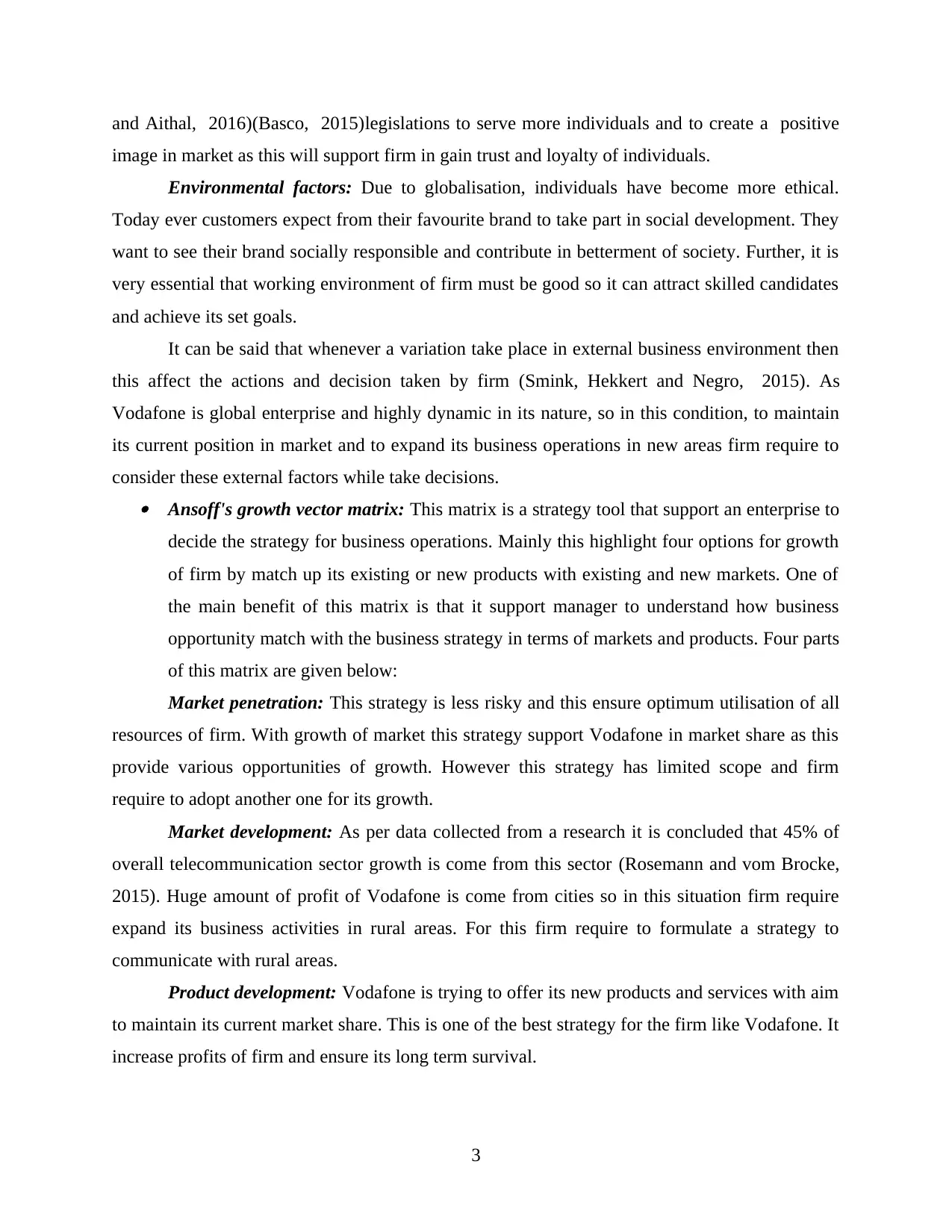
and Aithal, 2016)(Basco, 2015)legislations to serve more individuals and to create a positive
image in market as this will support firm in gain trust and loyalty of individuals.
Environmental factors: Due to globalisation, individuals have become more ethical.
Today ever customers expect from their favourite brand to take part in social development. They
want to see their brand socially responsible and contribute in betterment of society. Further, it is
very essential that working environment of firm must be good so it can attract skilled candidates
and achieve its set goals.
It can be said that whenever a variation take place in external business environment then
this affect the actions and decision taken by firm (Smink, Hekkert and Negro, 2015). As
Vodafone is global enterprise and highly dynamic in its nature, so in this condition, to maintain
its current position in market and to expand its business operations in new areas firm require to
consider these external factors while take decisions. Ansoff's growth vector matrix: This matrix is a strategy tool that support an enterprise to
decide the strategy for business operations. Mainly this highlight four options for growth
of firm by match up its existing or new products with existing and new markets. One of
the main benefit of this matrix is that it support manager to understand how business
opportunity match with the business strategy in terms of markets and products. Four parts
of this matrix are given below:
Market penetration: This strategy is less risky and this ensure optimum utilisation of all
resources of firm. With growth of market this strategy support Vodafone in market share as this
provide various opportunities of growth. However this strategy has limited scope and firm
require to adopt another one for its growth.
Market development: As per data collected from a research it is concluded that 45% of
overall telecommunication sector growth is come from this sector (Rosemann and vom Brocke,
2015). Huge amount of profit of Vodafone is come from cities so in this situation firm require
expand its business activities in rural areas. For this firm require to formulate a strategy to
communicate with rural areas.
Product development: Vodafone is trying to offer its new products and services with aim
to maintain its current market share. This is one of the best strategy for the firm like Vodafone. It
increase profits of firm and ensure its long term survival.
3
image in market as this will support firm in gain trust and loyalty of individuals.
Environmental factors: Due to globalisation, individuals have become more ethical.
Today ever customers expect from their favourite brand to take part in social development. They
want to see their brand socially responsible and contribute in betterment of society. Further, it is
very essential that working environment of firm must be good so it can attract skilled candidates
and achieve its set goals.
It can be said that whenever a variation take place in external business environment then
this affect the actions and decision taken by firm (Smink, Hekkert and Negro, 2015). As
Vodafone is global enterprise and highly dynamic in its nature, so in this condition, to maintain
its current position in market and to expand its business operations in new areas firm require to
consider these external factors while take decisions. Ansoff's growth vector matrix: This matrix is a strategy tool that support an enterprise to
decide the strategy for business operations. Mainly this highlight four options for growth
of firm by match up its existing or new products with existing and new markets. One of
the main benefit of this matrix is that it support manager to understand how business
opportunity match with the business strategy in terms of markets and products. Four parts
of this matrix are given below:
Market penetration: This strategy is less risky and this ensure optimum utilisation of all
resources of firm. With growth of market this strategy support Vodafone in market share as this
provide various opportunities of growth. However this strategy has limited scope and firm
require to adopt another one for its growth.
Market development: As per data collected from a research it is concluded that 45% of
overall telecommunication sector growth is come from this sector (Rosemann and vom Brocke,
2015). Huge amount of profit of Vodafone is come from cities so in this situation firm require
expand its business activities in rural areas. For this firm require to formulate a strategy to
communicate with rural areas.
Product development: Vodafone is trying to offer its new products and services with aim
to maintain its current market share. This is one of the best strategy for the firm like Vodafone. It
increase profits of firm and ensure its long term survival.
3
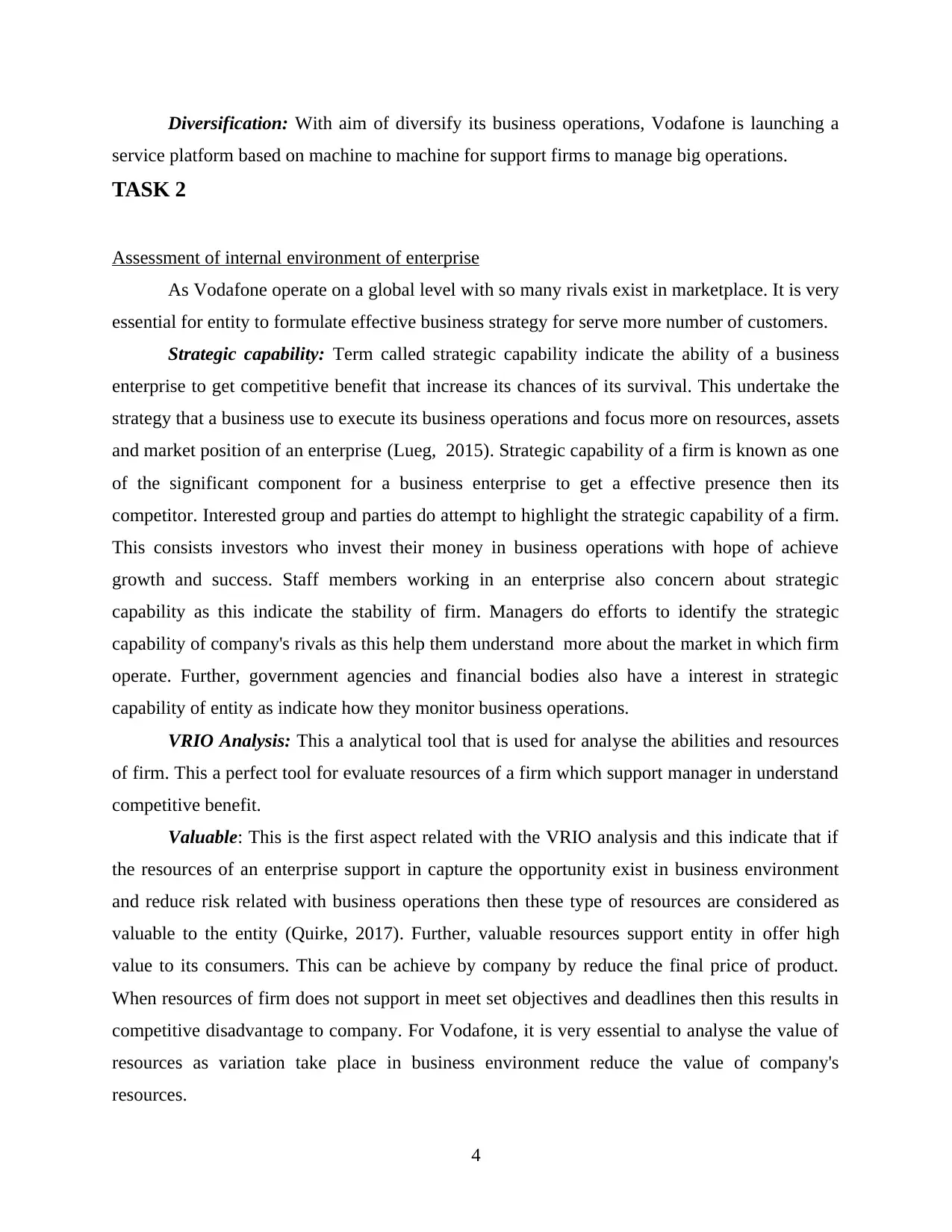
Diversification: With aim of diversify its business operations, Vodafone is launching a
service platform based on machine to machine for support firms to manage big operations.
TASK 2
Assessment of internal environment of enterprise
As Vodafone operate on a global level with so many rivals exist in marketplace. It is very
essential for entity to formulate effective business strategy for serve more number of customers.
Strategic capability: Term called strategic capability indicate the ability of a business
enterprise to get competitive benefit that increase its chances of its survival. This undertake the
strategy that a business use to execute its business operations and focus more on resources, assets
and market position of an enterprise (Lueg, 2015). Strategic capability of a firm is known as one
of the significant component for a business enterprise to get a effective presence then its
competitor. Interested group and parties do attempt to highlight the strategic capability of a firm.
This consists investors who invest their money in business operations with hope of achieve
growth and success. Staff members working in an enterprise also concern about strategic
capability as this indicate the stability of firm. Managers do efforts to identify the strategic
capability of company's rivals as this help them understand more about the market in which firm
operate. Further, government agencies and financial bodies also have a interest in strategic
capability of entity as indicate how they monitor business operations.
VRIO Analysis: This a analytical tool that is used for analyse the abilities and resources
of firm. This a perfect tool for evaluate resources of a firm which support manager in understand
competitive benefit.
Valuable: This is the first aspect related with the VRIO analysis and this indicate that if
the resources of an enterprise support in capture the opportunity exist in business environment
and reduce risk related with business operations then these type of resources are considered as
valuable to the entity (Quirke, 2017). Further, valuable resources support entity in offer high
value to its consumers. This can be achieve by company by reduce the final price of product.
When resources of firm does not support in meet set objectives and deadlines then this results in
competitive disadvantage to company. For Vodafone, it is very essential to analyse the value of
resources as variation take place in business environment reduce the value of company's
resources.
4
service platform based on machine to machine for support firms to manage big operations.
TASK 2
Assessment of internal environment of enterprise
As Vodafone operate on a global level with so many rivals exist in marketplace. It is very
essential for entity to formulate effective business strategy for serve more number of customers.
Strategic capability: Term called strategic capability indicate the ability of a business
enterprise to get competitive benefit that increase its chances of its survival. This undertake the
strategy that a business use to execute its business operations and focus more on resources, assets
and market position of an enterprise (Lueg, 2015). Strategic capability of a firm is known as one
of the significant component for a business enterprise to get a effective presence then its
competitor. Interested group and parties do attempt to highlight the strategic capability of a firm.
This consists investors who invest their money in business operations with hope of achieve
growth and success. Staff members working in an enterprise also concern about strategic
capability as this indicate the stability of firm. Managers do efforts to identify the strategic
capability of company's rivals as this help them understand more about the market in which firm
operate. Further, government agencies and financial bodies also have a interest in strategic
capability of entity as indicate how they monitor business operations.
VRIO Analysis: This a analytical tool that is used for analyse the abilities and resources
of firm. This a perfect tool for evaluate resources of a firm which support manager in understand
competitive benefit.
Valuable: This is the first aspect related with the VRIO analysis and this indicate that if
the resources of an enterprise support in capture the opportunity exist in business environment
and reduce risk related with business operations then these type of resources are considered as
valuable to the entity (Quirke, 2017). Further, valuable resources support entity in offer high
value to its consumers. This can be achieve by company by reduce the final price of product.
When resources of firm does not support in meet set objectives and deadlines then this results in
competitive disadvantage to company. For Vodafone, it is very essential to analyse the value of
resources as variation take place in business environment reduce the value of company's
resources.
4
⊘ This is a preview!⊘
Do you want full access?
Subscribe today to unlock all pages.

Trusted by 1+ million students worldwide
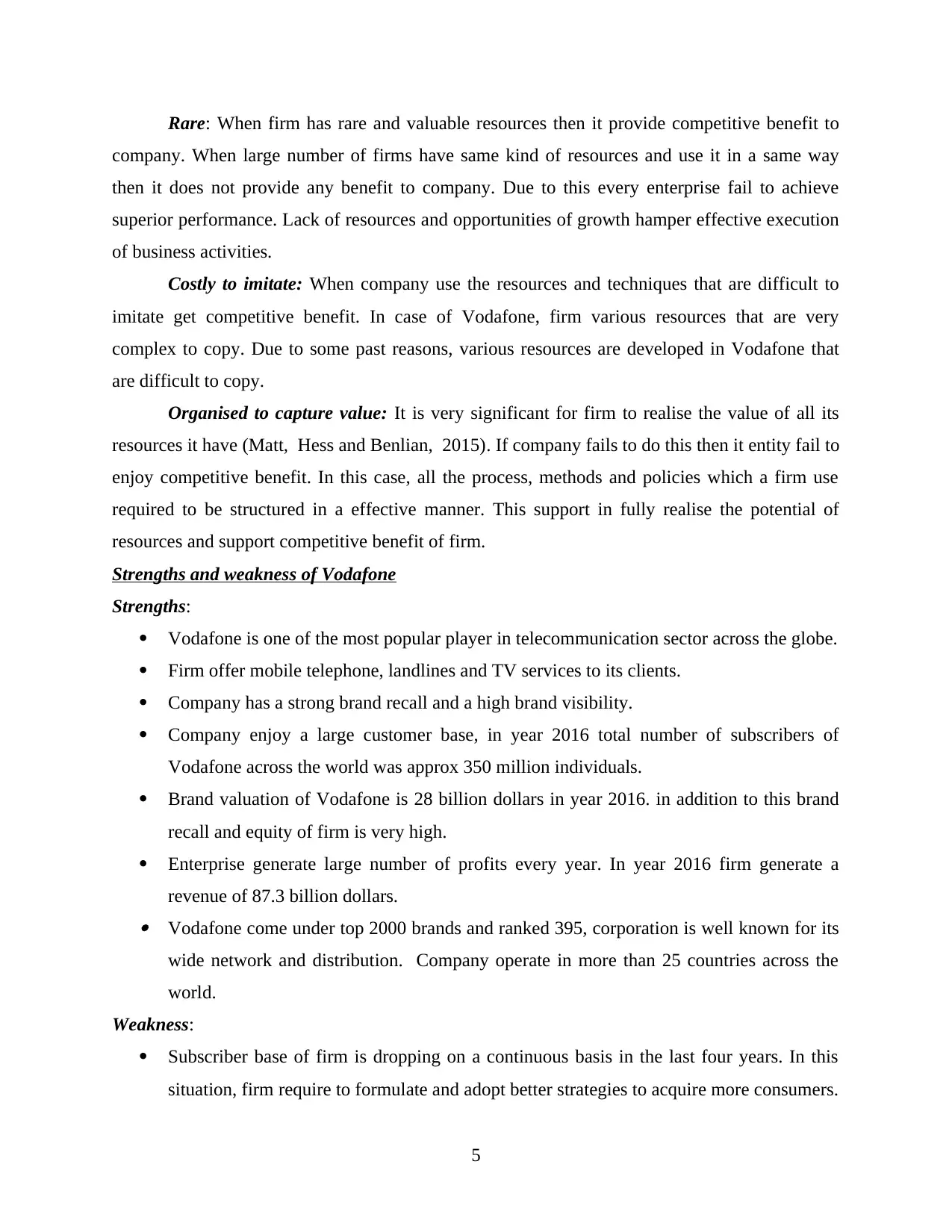
Rare: When firm has rare and valuable resources then it provide competitive benefit to
company. When large number of firms have same kind of resources and use it in a same way
then it does not provide any benefit to company. Due to this every enterprise fail to achieve
superior performance. Lack of resources and opportunities of growth hamper effective execution
of business activities.
Costly to imitate: When company use the resources and techniques that are difficult to
imitate get competitive benefit. In case of Vodafone, firm various resources that are very
complex to copy. Due to some past reasons, various resources are developed in Vodafone that
are difficult to copy.
Organised to capture value: It is very significant for firm to realise the value of all its
resources it have (Matt, Hess and Benlian, 2015). If company fails to do this then it entity fail to
enjoy competitive benefit. In this case, all the process, methods and policies which a firm use
required to be structured in a effective manner. This support in fully realise the potential of
resources and support competitive benefit of firm.
Strengths and weakness of Vodafone
Strengths:
Vodafone is one of the most popular player in telecommunication sector across the globe.
Firm offer mobile telephone, landlines and TV services to its clients.
Company has a strong brand recall and a high brand visibility.
Company enjoy a large customer base, in year 2016 total number of subscribers of
Vodafone across the world was approx 350 million individuals.
Brand valuation of Vodafone is 28 billion dollars in year 2016. in addition to this brand
recall and equity of firm is very high.
Enterprise generate large number of profits every year. In year 2016 firm generate a
revenue of 87.3 billion dollars. Vodafone come under top 2000 brands and ranked 395, corporation is well known for its
wide network and distribution. Company operate in more than 25 countries across the
world.
Weakness:
Subscriber base of firm is dropping on a continuous basis in the last four years. In this
situation, firm require to formulate and adopt better strategies to acquire more consumers.
5
company. When large number of firms have same kind of resources and use it in a same way
then it does not provide any benefit to company. Due to this every enterprise fail to achieve
superior performance. Lack of resources and opportunities of growth hamper effective execution
of business activities.
Costly to imitate: When company use the resources and techniques that are difficult to
imitate get competitive benefit. In case of Vodafone, firm various resources that are very
complex to copy. Due to some past reasons, various resources are developed in Vodafone that
are difficult to copy.
Organised to capture value: It is very significant for firm to realise the value of all its
resources it have (Matt, Hess and Benlian, 2015). If company fails to do this then it entity fail to
enjoy competitive benefit. In this case, all the process, methods and policies which a firm use
required to be structured in a effective manner. This support in fully realise the potential of
resources and support competitive benefit of firm.
Strengths and weakness of Vodafone
Strengths:
Vodafone is one of the most popular player in telecommunication sector across the globe.
Firm offer mobile telephone, landlines and TV services to its clients.
Company has a strong brand recall and a high brand visibility.
Company enjoy a large customer base, in year 2016 total number of subscribers of
Vodafone across the world was approx 350 million individuals.
Brand valuation of Vodafone is 28 billion dollars in year 2016. in addition to this brand
recall and equity of firm is very high.
Enterprise generate large number of profits every year. In year 2016 firm generate a
revenue of 87.3 billion dollars. Vodafone come under top 2000 brands and ranked 395, corporation is well known for its
wide network and distribution. Company operate in more than 25 countries across the
world.
Weakness:
Subscriber base of firm is dropping on a continuous basis in the last four years. In this
situation, firm require to formulate and adopt better strategies to acquire more consumers.
5
Paraphrase This Document
Need a fresh take? Get an instant paraphrase of this document with our AI Paraphraser
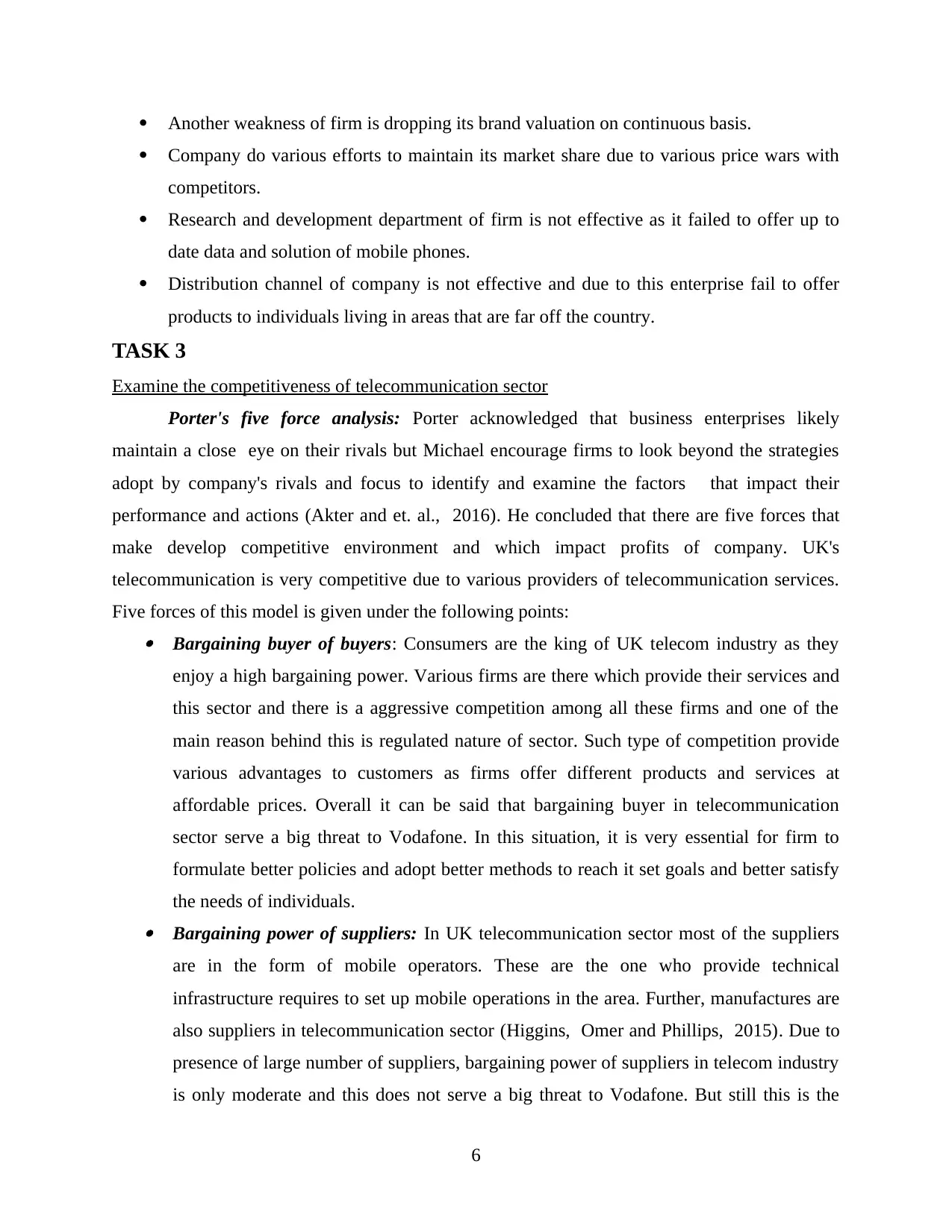
Another weakness of firm is dropping its brand valuation on continuous basis.
Company do various efforts to maintain its market share due to various price wars with
competitors.
Research and development department of firm is not effective as it failed to offer up to
date data and solution of mobile phones.
Distribution channel of company is not effective and due to this enterprise fail to offer
products to individuals living in areas that are far off the country.
TASK 3
Examine the competitiveness of telecommunication sector
Porter's five force analysis: Porter acknowledged that business enterprises likely
maintain a close eye on their rivals but Michael encourage firms to look beyond the strategies
adopt by company's rivals and focus to identify and examine the factors that impact their
performance and actions (Akter and et. al., 2016). He concluded that there are five forces that
make develop competitive environment and which impact profits of company. UK's
telecommunication is very competitive due to various providers of telecommunication services.
Five forces of this model is given under the following points: Bargaining buyer of buyers: Consumers are the king of UK telecom industry as they
enjoy a high bargaining power. Various firms are there which provide their services and
this sector and there is a aggressive competition among all these firms and one of the
main reason behind this is regulated nature of sector. Such type of competition provide
various advantages to customers as firms offer different products and services at
affordable prices. Overall it can be said that bargaining buyer in telecommunication
sector serve a big threat to Vodafone. In this situation, it is very essential for firm to
formulate better policies and adopt better methods to reach it set goals and better satisfy
the needs of individuals. Bargaining power of suppliers: In UK telecommunication sector most of the suppliers
are in the form of mobile operators. These are the one who provide technical
infrastructure requires to set up mobile operations in the area. Further, manufactures are
also suppliers in telecommunication sector (Higgins, Omer and Phillips, 2015). Due to
presence of large number of suppliers, bargaining power of suppliers in telecom industry
is only moderate and this does not serve a big threat to Vodafone. But still this is the
6
Company do various efforts to maintain its market share due to various price wars with
competitors.
Research and development department of firm is not effective as it failed to offer up to
date data and solution of mobile phones.
Distribution channel of company is not effective and due to this enterprise fail to offer
products to individuals living in areas that are far off the country.
TASK 3
Examine the competitiveness of telecommunication sector
Porter's five force analysis: Porter acknowledged that business enterprises likely
maintain a close eye on their rivals but Michael encourage firms to look beyond the strategies
adopt by company's rivals and focus to identify and examine the factors that impact their
performance and actions (Akter and et. al., 2016). He concluded that there are five forces that
make develop competitive environment and which impact profits of company. UK's
telecommunication is very competitive due to various providers of telecommunication services.
Five forces of this model is given under the following points: Bargaining buyer of buyers: Consumers are the king of UK telecom industry as they
enjoy a high bargaining power. Various firms are there which provide their services and
this sector and there is a aggressive competition among all these firms and one of the
main reason behind this is regulated nature of sector. Such type of competition provide
various advantages to customers as firms offer different products and services at
affordable prices. Overall it can be said that bargaining buyer in telecommunication
sector serve a big threat to Vodafone. In this situation, it is very essential for firm to
formulate better policies and adopt better methods to reach it set goals and better satisfy
the needs of individuals. Bargaining power of suppliers: In UK telecommunication sector most of the suppliers
are in the form of mobile operators. These are the one who provide technical
infrastructure requires to set up mobile operations in the area. Further, manufactures are
also suppliers in telecommunication sector (Higgins, Omer and Phillips, 2015). Due to
presence of large number of suppliers, bargaining power of suppliers in telecom industry
is only moderate and this does not serve a big threat to Vodafone. But still this is the
6
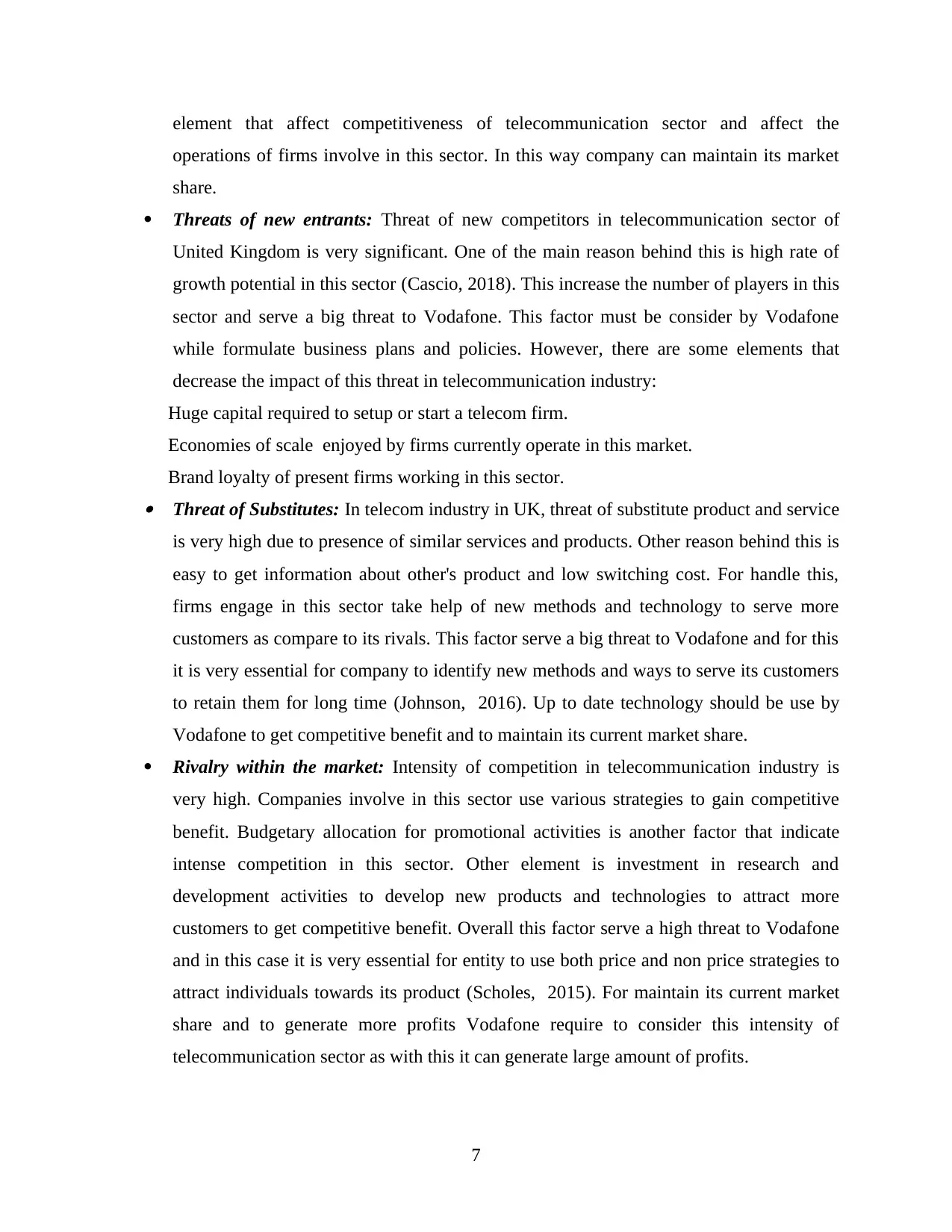
element that affect competitiveness of telecommunication sector and affect the
operations of firms involve in this sector. In this way company can maintain its market
share.
Threats of new entrants: Threat of new competitors in telecommunication sector of
United Kingdom is very significant. One of the main reason behind this is high rate of
growth potential in this sector (Cascio, 2018). This increase the number of players in this
sector and serve a big threat to Vodafone. This factor must be consider by Vodafone
while formulate business plans and policies. However, there are some elements that
decrease the impact of this threat in telecommunication industry:
Huge capital required to setup or start a telecom firm.
Economies of scale enjoyed by firms currently operate in this market.
Brand loyalty of present firms working in this sector. Threat of Substitutes: In telecom industry in UK, threat of substitute product and service
is very high due to presence of similar services and products. Other reason behind this is
easy to get information about other's product and low switching cost. For handle this,
firms engage in this sector take help of new methods and technology to serve more
customers as compare to its rivals. This factor serve a big threat to Vodafone and for this
it is very essential for company to identify new methods and ways to serve its customers
to retain them for long time (Johnson, 2016). Up to date technology should be use by
Vodafone to get competitive benefit and to maintain its current market share.
Rivalry within the market: Intensity of competition in telecommunication industry is
very high. Companies involve in this sector use various strategies to gain competitive
benefit. Budgetary allocation for promotional activities is another factor that indicate
intense competition in this sector. Other element is investment in research and
development activities to develop new products and technologies to attract more
customers to get competitive benefit. Overall this factor serve a high threat to Vodafone
and in this case it is very essential for entity to use both price and non price strategies to
attract individuals towards its product (Scholes, 2015). For maintain its current market
share and to generate more profits Vodafone require to consider this intensity of
telecommunication sector as with this it can generate large amount of profits.
7
operations of firms involve in this sector. In this way company can maintain its market
share.
Threats of new entrants: Threat of new competitors in telecommunication sector of
United Kingdom is very significant. One of the main reason behind this is high rate of
growth potential in this sector (Cascio, 2018). This increase the number of players in this
sector and serve a big threat to Vodafone. This factor must be consider by Vodafone
while formulate business plans and policies. However, there are some elements that
decrease the impact of this threat in telecommunication industry:
Huge capital required to setup or start a telecom firm.
Economies of scale enjoyed by firms currently operate in this market.
Brand loyalty of present firms working in this sector. Threat of Substitutes: In telecom industry in UK, threat of substitute product and service
is very high due to presence of similar services and products. Other reason behind this is
easy to get information about other's product and low switching cost. For handle this,
firms engage in this sector take help of new methods and technology to serve more
customers as compare to its rivals. This factor serve a big threat to Vodafone and for this
it is very essential for company to identify new methods and ways to serve its customers
to retain them for long time (Johnson, 2016). Up to date technology should be use by
Vodafone to get competitive benefit and to maintain its current market share.
Rivalry within the market: Intensity of competition in telecommunication industry is
very high. Companies involve in this sector use various strategies to gain competitive
benefit. Budgetary allocation for promotional activities is another factor that indicate
intense competition in this sector. Other element is investment in research and
development activities to develop new products and technologies to attract more
customers to get competitive benefit. Overall this factor serve a high threat to Vodafone
and in this case it is very essential for entity to use both price and non price strategies to
attract individuals towards its product (Scholes, 2015). For maintain its current market
share and to generate more profits Vodafone require to consider this intensity of
telecommunication sector as with this it can generate large amount of profits.
7
⊘ This is a preview!⊘
Do you want full access?
Subscribe today to unlock all pages.

Trusted by 1+ million students worldwide
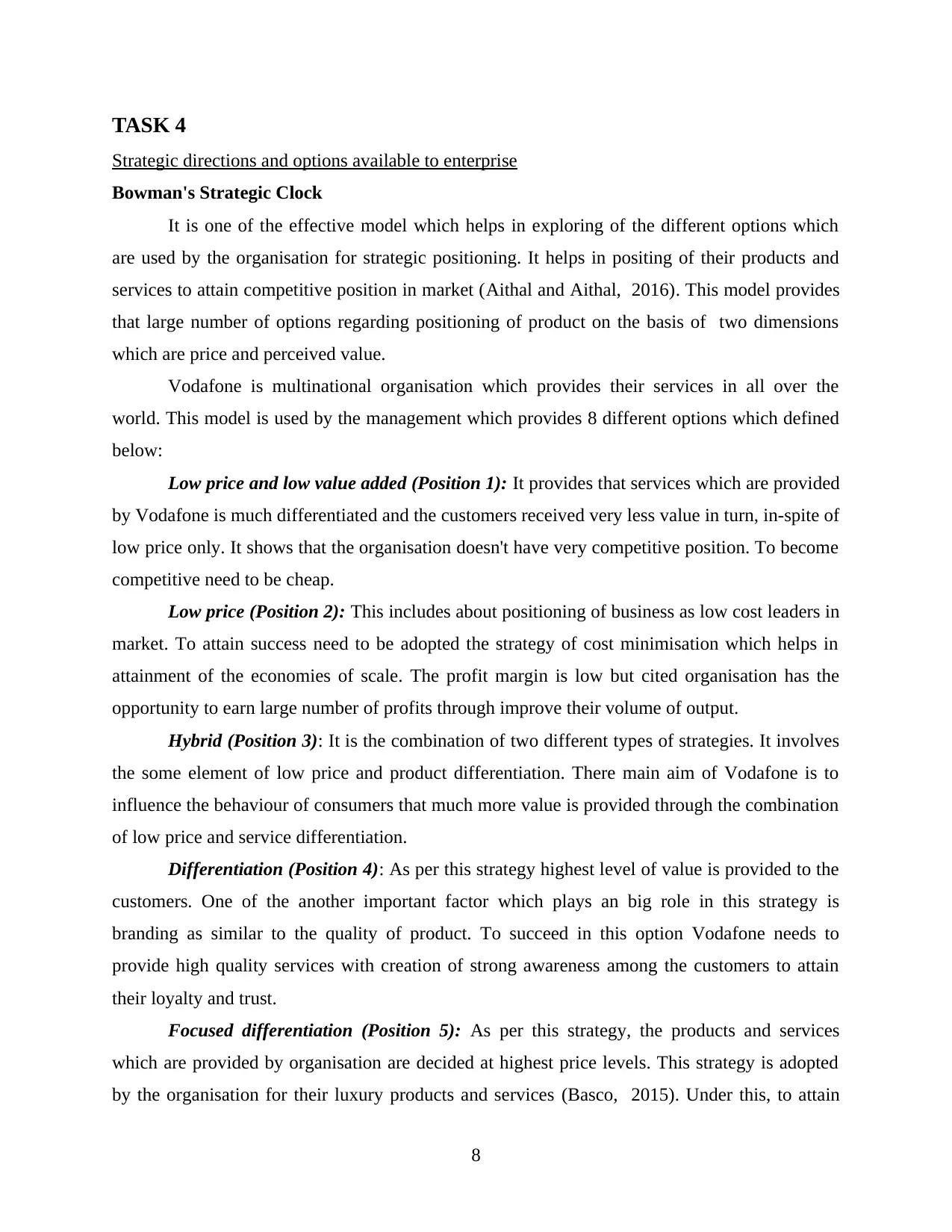
TASK 4
Strategic directions and options available to enterprise
Bowman's Strategic Clock
It is one of the effective model which helps in exploring of the different options which
are used by the organisation for strategic positioning. It helps in positing of their products and
services to attain competitive position in market (Aithal and Aithal, 2016). This model provides
that large number of options regarding positioning of product on the basis of two dimensions
which are price and perceived value.
Vodafone is multinational organisation which provides their services in all over the
world. This model is used by the management which provides 8 different options which defined
below:
Low price and low value added (Position 1): It provides that services which are provided
by Vodafone is much differentiated and the customers received very less value in turn, in-spite of
low price only. It shows that the organisation doesn't have very competitive position. To become
competitive need to be cheap.
Low price (Position 2): This includes about positioning of business as low cost leaders in
market. To attain success need to be adopted the strategy of cost minimisation which helps in
attainment of the economies of scale. The profit margin is low but cited organisation has the
opportunity to earn large number of profits through improve their volume of output.
Hybrid (Position 3): It is the combination of two different types of strategies. It involves
the some element of low price and product differentiation. There main aim of Vodafone is to
influence the behaviour of consumers that much more value is provided through the combination
of low price and service differentiation.
Differentiation (Position 4): As per this strategy highest level of value is provided to the
customers. One of the another important factor which plays an big role in this strategy is
branding as similar to the quality of product. To succeed in this option Vodafone needs to
provide high quality services with creation of strong awareness among the customers to attain
their loyalty and trust.
Focused differentiation (Position 5): As per this strategy, the products and services
which are provided by organisation are decided at highest price levels. This strategy is adopted
by the organisation for their luxury products and services (Basco, 2015). Under this, to attain
8
Strategic directions and options available to enterprise
Bowman's Strategic Clock
It is one of the effective model which helps in exploring of the different options which
are used by the organisation for strategic positioning. It helps in positing of their products and
services to attain competitive position in market (Aithal and Aithal, 2016). This model provides
that large number of options regarding positioning of product on the basis of two dimensions
which are price and perceived value.
Vodafone is multinational organisation which provides their services in all over the
world. This model is used by the management which provides 8 different options which defined
below:
Low price and low value added (Position 1): It provides that services which are provided
by Vodafone is much differentiated and the customers received very less value in turn, in-spite of
low price only. It shows that the organisation doesn't have very competitive position. To become
competitive need to be cheap.
Low price (Position 2): This includes about positioning of business as low cost leaders in
market. To attain success need to be adopted the strategy of cost minimisation which helps in
attainment of the economies of scale. The profit margin is low but cited organisation has the
opportunity to earn large number of profits through improve their volume of output.
Hybrid (Position 3): It is the combination of two different types of strategies. It involves
the some element of low price and product differentiation. There main aim of Vodafone is to
influence the behaviour of consumers that much more value is provided through the combination
of low price and service differentiation.
Differentiation (Position 4): As per this strategy highest level of value is provided to the
customers. One of the another important factor which plays an big role in this strategy is
branding as similar to the quality of product. To succeed in this option Vodafone needs to
provide high quality services with creation of strong awareness among the customers to attain
their loyalty and trust.
Focused differentiation (Position 5): As per this strategy, the products and services
which are provided by organisation are decided at highest price levels. This strategy is adopted
by the organisation for their luxury products and services (Basco, 2015). Under this, to attain
8
Paraphrase This Document
Need a fresh take? Get an instant paraphrase of this document with our AI Paraphraser
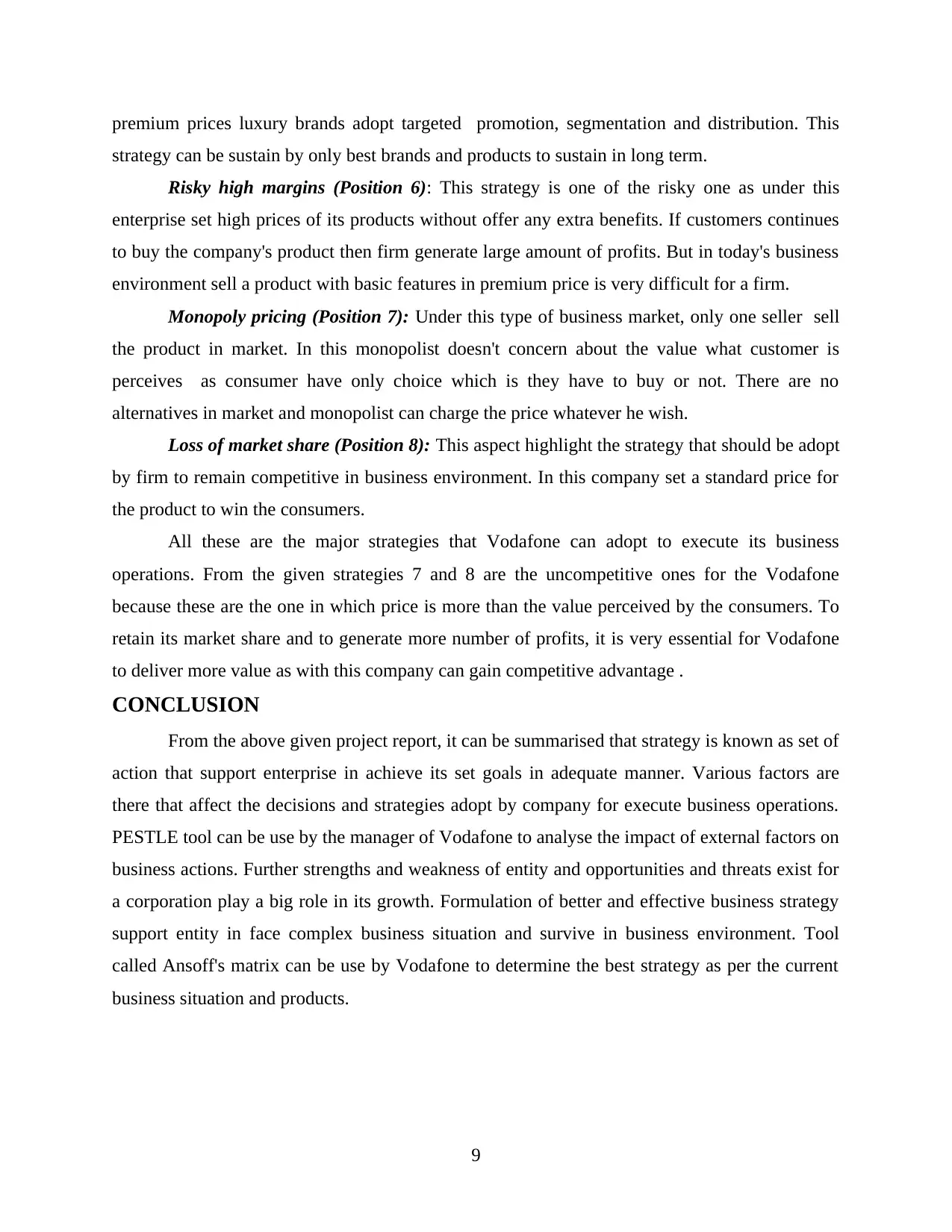
premium prices luxury brands adopt targeted promotion, segmentation and distribution. This
strategy can be sustain by only best brands and products to sustain in long term.
Risky high margins (Position 6): This strategy is one of the risky one as under this
enterprise set high prices of its products without offer any extra benefits. If customers continues
to buy the company's product then firm generate large amount of profits. But in today's business
environment sell a product with basic features in premium price is very difficult for a firm.
Monopoly pricing (Position 7): Under this type of business market, only one seller sell
the product in market. In this monopolist doesn't concern about the value what customer is
perceives as consumer have only choice which is they have to buy or not. There are no
alternatives in market and monopolist can charge the price whatever he wish.
Loss of market share (Position 8): This aspect highlight the strategy that should be adopt
by firm to remain competitive in business environment. In this company set a standard price for
the product to win the consumers.
All these are the major strategies that Vodafone can adopt to execute its business
operations. From the given strategies 7 and 8 are the uncompetitive ones for the Vodafone
because these are the one in which price is more than the value perceived by the consumers. To
retain its market share and to generate more number of profits, it is very essential for Vodafone
to deliver more value as with this company can gain competitive advantage .
CONCLUSION
From the above given project report, it can be summarised that strategy is known as set of
action that support enterprise in achieve its set goals in adequate manner. Various factors are
there that affect the decisions and strategies adopt by company for execute business operations.
PESTLE tool can be use by the manager of Vodafone to analyse the impact of external factors on
business actions. Further strengths and weakness of entity and opportunities and threats exist for
a corporation play a big role in its growth. Formulation of better and effective business strategy
support entity in face complex business situation and survive in business environment. Tool
called Ansoff's matrix can be use by Vodafone to determine the best strategy as per the current
business situation and products.
9
strategy can be sustain by only best brands and products to sustain in long term.
Risky high margins (Position 6): This strategy is one of the risky one as under this
enterprise set high prices of its products without offer any extra benefits. If customers continues
to buy the company's product then firm generate large amount of profits. But in today's business
environment sell a product with basic features in premium price is very difficult for a firm.
Monopoly pricing (Position 7): Under this type of business market, only one seller sell
the product in market. In this monopolist doesn't concern about the value what customer is
perceives as consumer have only choice which is they have to buy or not. There are no
alternatives in market and monopolist can charge the price whatever he wish.
Loss of market share (Position 8): This aspect highlight the strategy that should be adopt
by firm to remain competitive in business environment. In this company set a standard price for
the product to win the consumers.
All these are the major strategies that Vodafone can adopt to execute its business
operations. From the given strategies 7 and 8 are the uncompetitive ones for the Vodafone
because these are the one in which price is more than the value perceived by the consumers. To
retain its market share and to generate more number of profits, it is very essential for Vodafone
to deliver more value as with this company can gain competitive advantage .
CONCLUSION
From the above given project report, it can be summarised that strategy is known as set of
action that support enterprise in achieve its set goals in adequate manner. Various factors are
there that affect the decisions and strategies adopt by company for execute business operations.
PESTLE tool can be use by the manager of Vodafone to analyse the impact of external factors on
business actions. Further strengths and weakness of entity and opportunities and threats exist for
a corporation play a big role in its growth. Formulation of better and effective business strategy
support entity in face complex business situation and survive in business environment. Tool
called Ansoff's matrix can be use by Vodafone to determine the best strategy as per the current
business situation and products.
9
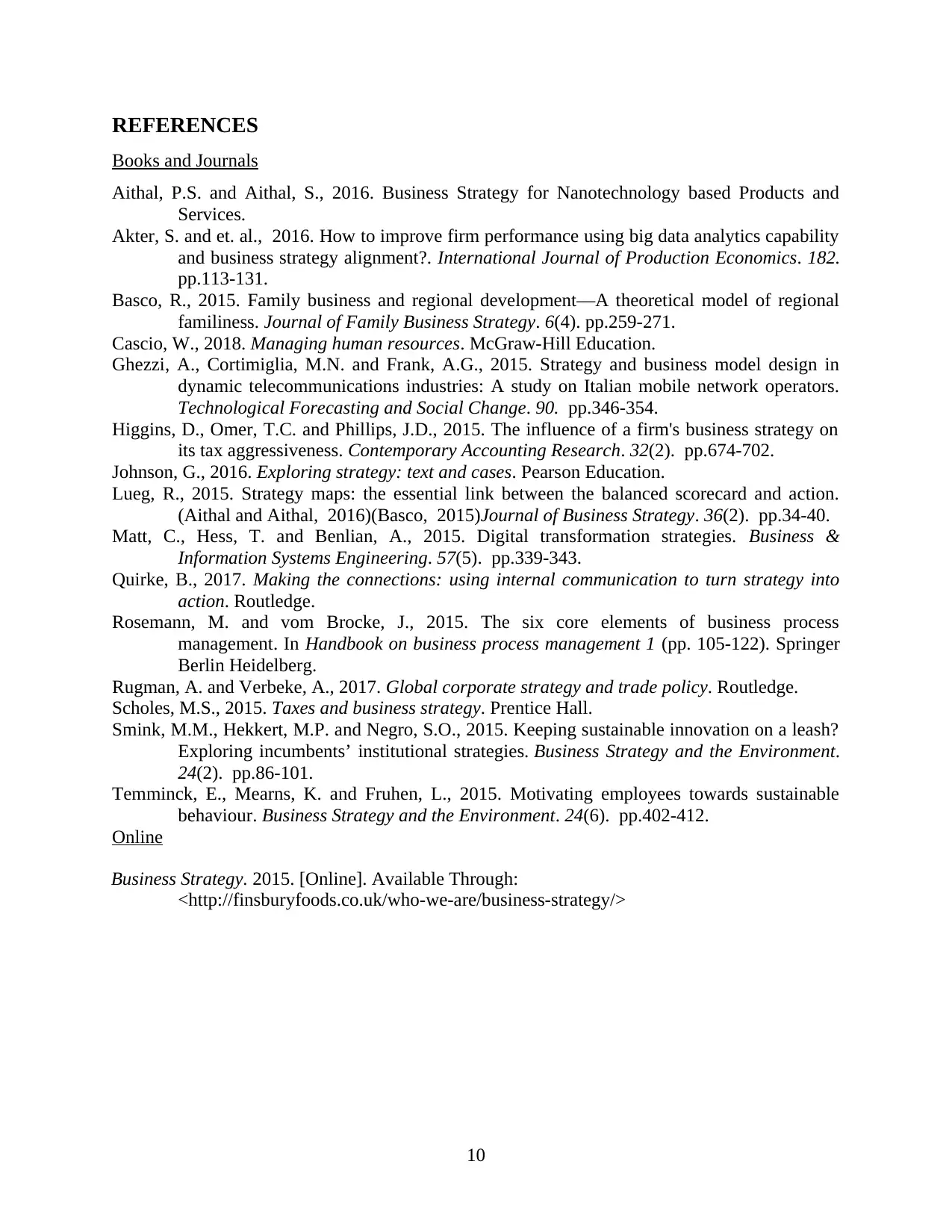
REFERENCES
Books and Journals
Aithal, P.S. and Aithal, S., 2016. Business Strategy for Nanotechnology based Products and
Services.
Akter, S. and et. al., 2016. How to improve firm performance using big data analytics capability
and business strategy alignment?. International Journal of Production Economics. 182.
pp.113-131.
Basco, R., 2015. Family business and regional development—A theoretical model of regional
familiness. Journal of Family Business Strategy. 6(4). pp.259-271.
Cascio, W., 2018. Managing human resources. McGraw-Hill Education.
Ghezzi, A., Cortimiglia, M.N. and Frank, A.G., 2015. Strategy and business model design in
dynamic telecommunications industries: A study on Italian mobile network operators.
Technological Forecasting and Social Change. 90. pp.346-354.
Higgins, D., Omer, T.C. and Phillips, J.D., 2015. The influence of a firm's business strategy on
its tax aggressiveness. Contemporary Accounting Research. 32(2). pp.674-702.
Johnson, G., 2016. Exploring strategy: text and cases. Pearson Education.
Lueg, R., 2015. Strategy maps: the essential link between the balanced scorecard and action.
(Aithal and Aithal, 2016)(Basco, 2015)Journal of Business Strategy. 36(2). pp.34-40.
Matt, C., Hess, T. and Benlian, A., 2015. Digital transformation strategies. Business &
Information Systems Engineering. 57(5). pp.339-343.
Quirke, B., 2017. Making the connections: using internal communication to turn strategy into
action. Routledge.
Rosemann, M. and vom Brocke, J., 2015. The six core elements of business process
management. In Handbook on business process management 1 (pp. 105-122). Springer
Berlin Heidelberg.
Rugman, A. and Verbeke, A., 2017. Global corporate strategy and trade policy. Routledge.
Scholes, M.S., 2015. Taxes and business strategy. Prentice Hall.
Smink, M.M., Hekkert, M.P. and Negro, S.O., 2015. Keeping sustainable innovation on a leash?
Exploring incumbents’ institutional strategies. Business Strategy and the Environment.
24(2). pp.86-101.
Temminck, E., Mearns, K. and Fruhen, L., 2015. Motivating employees towards sustainable
behaviour. Business Strategy and the Environment. 24(6). pp.402-412.
Online
Business Strategy. 2015. [Online]. Available Through:
<http://finsburyfoods.co.uk/who-we-are/business-strategy/>
10
Books and Journals
Aithal, P.S. and Aithal, S., 2016. Business Strategy for Nanotechnology based Products and
Services.
Akter, S. and et. al., 2016. How to improve firm performance using big data analytics capability
and business strategy alignment?. International Journal of Production Economics. 182.
pp.113-131.
Basco, R., 2015. Family business and regional development—A theoretical model of regional
familiness. Journal of Family Business Strategy. 6(4). pp.259-271.
Cascio, W., 2018. Managing human resources. McGraw-Hill Education.
Ghezzi, A., Cortimiglia, M.N. and Frank, A.G., 2015. Strategy and business model design in
dynamic telecommunications industries: A study on Italian mobile network operators.
Technological Forecasting and Social Change. 90. pp.346-354.
Higgins, D., Omer, T.C. and Phillips, J.D., 2015. The influence of a firm's business strategy on
its tax aggressiveness. Contemporary Accounting Research. 32(2). pp.674-702.
Johnson, G., 2016. Exploring strategy: text and cases. Pearson Education.
Lueg, R., 2015. Strategy maps: the essential link between the balanced scorecard and action.
(Aithal and Aithal, 2016)(Basco, 2015)Journal of Business Strategy. 36(2). pp.34-40.
Matt, C., Hess, T. and Benlian, A., 2015. Digital transformation strategies. Business &
Information Systems Engineering. 57(5). pp.339-343.
Quirke, B., 2017. Making the connections: using internal communication to turn strategy into
action. Routledge.
Rosemann, M. and vom Brocke, J., 2015. The six core elements of business process
management. In Handbook on business process management 1 (pp. 105-122). Springer
Berlin Heidelberg.
Rugman, A. and Verbeke, A., 2017. Global corporate strategy and trade policy. Routledge.
Scholes, M.S., 2015. Taxes and business strategy. Prentice Hall.
Smink, M.M., Hekkert, M.P. and Negro, S.O., 2015. Keeping sustainable innovation on a leash?
Exploring incumbents’ institutional strategies. Business Strategy and the Environment.
24(2). pp.86-101.
Temminck, E., Mearns, K. and Fruhen, L., 2015. Motivating employees towards sustainable
behaviour. Business Strategy and the Environment. 24(6). pp.402-412.
Online
Business Strategy. 2015. [Online]. Available Through:
<http://finsburyfoods.co.uk/who-we-are/business-strategy/>
10
⊘ This is a preview!⊘
Do you want full access?
Subscribe today to unlock all pages.

Trusted by 1+ million students worldwide
1 out of 12
Related Documents
Your All-in-One AI-Powered Toolkit for Academic Success.
+13062052269
info@desklib.com
Available 24*7 on WhatsApp / Email
![[object Object]](/_next/static/media/star-bottom.7253800d.svg)
Unlock your academic potential
Copyright © 2020–2025 A2Z Services. All Rights Reserved. Developed and managed by ZUCOL.





